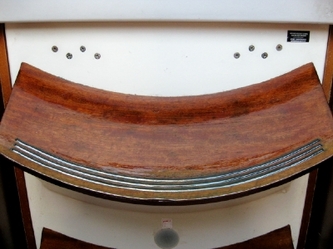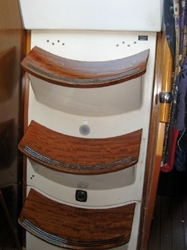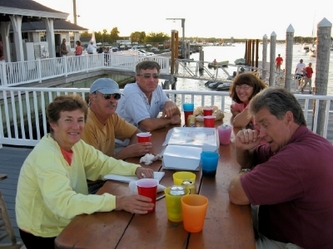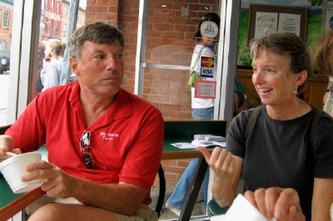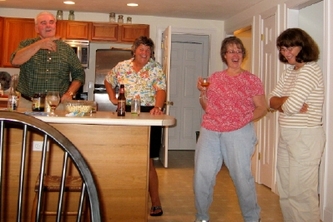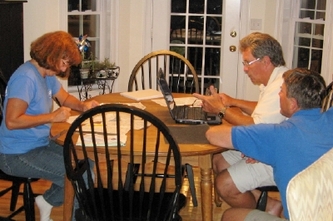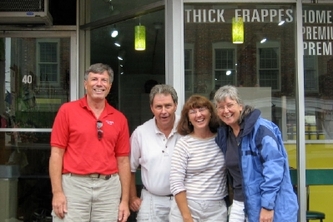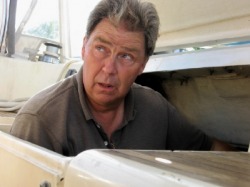
We’ve made it up to New Hampshire, as we prepare to set sail – but not on Orion this time. For the first time, we will both serve as crew, helping Fred sail Marianna south to the Chesapeake. It doesn’t mean we’ve turned our back on Orion, since we had to get herready to stay on her own without us. But it was a new adventure to turn our attention to Marianna as we helped prepare her for her winter journeys on southern waters.
Named Storms
Gustav, Hannah, Ike, Josephine. It was becoming an endless stream of names as the storms formed and moved across the Atlantic toward North America. As we prepared to leave Orion for an extended time, we were watching all this tropical activity with intense interest. Which of them would head toward the Chesapeake and become a threat we had to deal with? And what was lurking behind them (Kyle?) that would come after we were away? So, our plans to secure Orion for our extended time away was given a new sense of urgency as we began to look at a real name headed our way. In this case, it turned out to be Hannah.
We had already planned to remove the enclosure to reduce windage. Cathy took this opportunity to give all the panels a thorough cleaning and then store them below decks. With the glass safely out of the way, it was a good time to clean and waterproof the bimini. Although we had originally planned to leave this up while we were gone, we changed course and decided to take it down as well. Then we secured the bimini poles to keep them from being damaged by any wind.
To finish the above decks preparation, Dave lashed the small tail of the main more securely around the mast and put an extra wrap around the headsail. Then we began having discussions with other cruisers about their preparations. Most had removed their headsail before being hauled, since it might come unfurled in a strong wind and make the boat unstable. Removing it now was more problematic since we were already on the hard, and unfurling the sail to drop it could de-stabilize Orion in her jack stands. But early the next morning the air was still without a hint of a breeze. So we decided to take advantage of the calm air and remove the headsail. This, along with the removal of the enclosure ensured Orion had the least amount of windage during the coming storms.
To prepare for the rain that was sure to come with the storm, Cathy double-checked her recent re-sealing of the portlights by an intense soaking with a hose to simulate a persistent downpour. Only one showed any signs of water penetrating to the cabin, so she re-sealed the seam on this one to hopefully close the gap. To hedge our bets, we still put containers under all the portlights to catch any water that did make it through.
With Orion protected above and below decks, we then ensured there was no clutter below decks, removing the water hose, and disconnecting the shore power cords and securing them in the lazarettes where they are normally stored. Knowing that we planned to disconnect the shore power, Dave spent a day before we left equalizing the batteries, and Cathy cleaned out the fridge, since we planned to turn off all the breakers. This would ensure the batteries would be in the best shape possible when we returned. As we left the boat, after locking the hatch boards in place, we removed the extension ladder that had been our lifeline in and out of the boat and folded the swim ladder back up, securing it to the stanchion as we normally do.
With nothing more we could do, we drove away hoping we hadn’t missed anything important. Our friends in the yard assured us they would let us know how she fared as the storms passed through. The good news we learned a few days later was that Hannah had little impact with winds that peaked at 45 knots. Orion was fine and would likely continue to be until we saw her again.
Named Storms
Gustav, Hannah, Ike, Josephine. It was becoming an endless stream of names as the storms formed and moved across the Atlantic toward North America. As we prepared to leave Orion for an extended time, we were watching all this tropical activity with intense interest. Which of them would head toward the Chesapeake and become a threat we had to deal with? And what was lurking behind them (Kyle?) that would come after we were away? So, our plans to secure Orion for our extended time away was given a new sense of urgency as we began to look at a real name headed our way. In this case, it turned out to be Hannah.
We had already planned to remove the enclosure to reduce windage. Cathy took this opportunity to give all the panels a thorough cleaning and then store them below decks. With the glass safely out of the way, it was a good time to clean and waterproof the bimini. Although we had originally planned to leave this up while we were gone, we changed course and decided to take it down as well. Then we secured the bimini poles to keep them from being damaged by any wind.
To finish the above decks preparation, Dave lashed the small tail of the main more securely around the mast and put an extra wrap around the headsail. Then we began having discussions with other cruisers about their preparations. Most had removed their headsail before being hauled, since it might come unfurled in a strong wind and make the boat unstable. Removing it now was more problematic since we were already on the hard, and unfurling the sail to drop it could de-stabilize Orion in her jack stands. But early the next morning the air was still without a hint of a breeze. So we decided to take advantage of the calm air and remove the headsail. This, along with the removal of the enclosure ensured Orion had the least amount of windage during the coming storms.
To prepare for the rain that was sure to come with the storm, Cathy double-checked her recent re-sealing of the portlights by an intense soaking with a hose to simulate a persistent downpour. Only one showed any signs of water penetrating to the cabin, so she re-sealed the seam on this one to hopefully close the gap. To hedge our bets, we still put containers under all the portlights to catch any water that did make it through.
With Orion protected above and below decks, we then ensured there was no clutter below decks, removing the water hose, and disconnecting the shore power cords and securing them in the lazarettes where they are normally stored. Knowing that we planned to disconnect the shore power, Dave spent a day before we left equalizing the batteries, and Cathy cleaned out the fridge, since we planned to turn off all the breakers. This would ensure the batteries would be in the best shape possible when we returned. As we left the boat, after locking the hatch boards in place, we removed the extension ladder that had been our lifeline in and out of the boat and folded the swim ladder back up, securing it to the stanchion as we normally do.
With nothing more we could do, we drove away hoping we hadn’t missed anything important. Our friends in the yard assured us they would let us know how she fared as the storms passed through. The good news we learned a few days later was that Hannah had little impact with winds that peaked at 45 knots. Orion was fine and would likely continue to be until we saw her again.
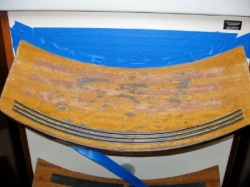
Steps before refinishing
Shine On
While the exterior teak on Orion has gotten a facelift regularly since it was restored back in 2006, the interior woodwork has had one problem area crying out for attention – the companionway stairs. Unlike the rest of the wood below deck, these looked awful. The finish had been chipped away by years of traffic and the inevitable water and dirt that goes along with that. Something had to be done, but timing was everything. Taking the stairs out of commission greatly complicates any on-going projects, and it is certainly out of the question while traveling. We therefore had a narrow window of opportunity after the boatyard workers were done and before we left the boat to try to finally re-finish the stairs.
Cathy had done the research about how to refinish the stairs according to Beneteau’s instructions (found on their website) and gave up in frustration. The procedure was incredibly complex, involving many applications of sprayed on lacquer. It seemed the likelihood of doing this successfully was going to be small. After talking with other cruisers who had re-finished wood in the cabin, we decided to go for a simpler approach. We would strip the wood and apply either polyurethane or varnish. Even though this would not exactly match the interior finish on the other surfaces, it would be far better than the way they looked now.
While the exterior teak on Orion has gotten a facelift regularly since it was restored back in 2006, the interior woodwork has had one problem area crying out for attention – the companionway stairs. Unlike the rest of the wood below deck, these looked awful. The finish had been chipped away by years of traffic and the inevitable water and dirt that goes along with that. Something had to be done, but timing was everything. Taking the stairs out of commission greatly complicates any on-going projects, and it is certainly out of the question while traveling. We therefore had a narrow window of opportunity after the boatyard workers were done and before we left the boat to try to finally re-finish the stairs.
Cathy had done the research about how to refinish the stairs according to Beneteau’s instructions (found on their website) and gave up in frustration. The procedure was incredibly complex, involving many applications of sprayed on lacquer. It seemed the likelihood of doing this successfully was going to be small. After talking with other cruisers who had re-finished wood in the cabin, we decided to go for a simpler approach. We would strip the wood and apply either polyurethane or varnish. Even though this would not exactly match the interior finish on the other surfaces, it would be far better than the way they looked now.
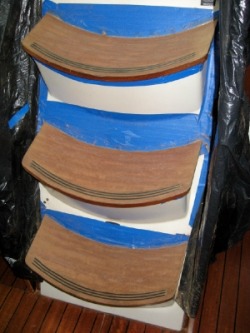
Steps after stripping and sanding
So, Cathy first stripped the existing finish from all 3 stairs, being careful to keep the caustic chemicals off the fiberglass surfaces that surrounded and supported them. With the finish removed, the steps still looked pretty bad. The water had darkened the wood, where the finish had worn away, and the non-skid strips that we had added for safety had not come off cleanly. So, Cathy began carefully sanding the stairs to smooth out the finish, without wearing through the top layer of wood. (The steps are many layers of wood glued together to produce the curved shape.) Going from 60 to 100 to 150 to 220, she was finally ready with a smooth surface. We decided to use Captain’s Z-spar varnish for the finish, and because it would be a high-traffic area, Cathy applied 7 coats, leaving them to dry almost 24 hours between coats, sanding between each.
It was time-consuming, but the results were worth it. The steps look so much better now.
It was time-consuming, but the results were worth it. The steps look so much better now.
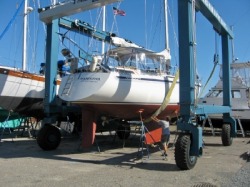
Marianna moves toward the water
Marianna, Here We Come
Over the summer, we had been talking to Pat and Fred and working out a plan to help them move Marianna south from New Hampshire early, so that they could enjoy the Chesapeake for a few weeks in October (including the Annapolis Boat Show) instead of spending that time rushing south after Pat’s business closed for the season. We made arrangements to fly to Boston on Sept 6th from Baltimore, with the expectation that we would start the return trip on the 15th, weather- and Marianna-permitting.
After leaving Deltaville, we made our way north to Annapolis, where we would run a few errands (which included dropping the old headsail off at our Neil Pryde dealer’s house for a little re-stitching to ensure it will last until our new one is ready) and then meet up with George and Gail Braun, a couple that we had met at last year’s boat show. They lived in Pasadena, MD and had cruised one winter with Pat and Fred, coming back from Georgetown and up the Florida coast together. They graciously agreed to not only let us leave our car at their house, but to put us up for the night and drive us to the airport. We had a delightful evening together, and the next morning parted with promises to see them again in maybe a couple of weeks, possibly sailing up the Magothy to their dock on Marianna.
Over the summer, we had been talking to Pat and Fred and working out a plan to help them move Marianna south from New Hampshire early, so that they could enjoy the Chesapeake for a few weeks in October (including the Annapolis Boat Show) instead of spending that time rushing south after Pat’s business closed for the season. We made arrangements to fly to Boston on Sept 6th from Baltimore, with the expectation that we would start the return trip on the 15th, weather- and Marianna-permitting.
After leaving Deltaville, we made our way north to Annapolis, where we would run a few errands (which included dropping the old headsail off at our Neil Pryde dealer’s house for a little re-stitching to ensure it will last until our new one is ready) and then meet up with George and Gail Braun, a couple that we had met at last year’s boat show. They lived in Pasadena, MD and had cruised one winter with Pat and Fred, coming back from Georgetown and up the Florida coast together. They graciously agreed to not only let us leave our car at their house, but to put us up for the night and drive us to the airport. We had a delightful evening together, and the next morning parted with promises to see them again in maybe a couple of weeks, possibly sailing up the Magothy to their dock on Marianna.
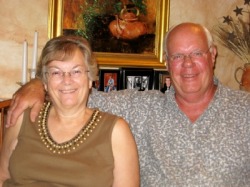
Gail and George, our hosts in Pasadena, MD
As Hannah moved over the Baltimore area, we took off in the rain, but didn’t leave her behind. By the time we joined Pat and Fred Saturday evening, as planned, the rains had caught up with us again. (Boy, did she move fast.) We spent the next week in a flurry of activity. Generally, the daytime hours were divided between running errands, provisioning and stowing gear on Marianna and doing anything else that needed doing before Fred and the boat could leave. Many evenings were spent either enjoying the company of old friends, such as Dave and Donna on Merlin, enjoying a little time with Pat and Fred or meeting their friends as they came to say goodbye. .
With Pat’s intensive work schedule and the number of last-minute items that always have to be done to get a boat ready to go, we frequently were up early and getting home late, gradually reducing the list of things to be done, but keeping busy doing it. Despite the long days, we thoroughly enjoyed our time together and look forward to being reunited in early October when Pat joins Fred in Annapolis.
